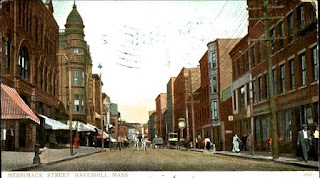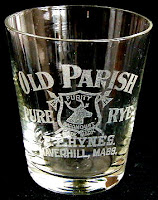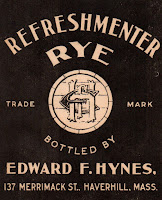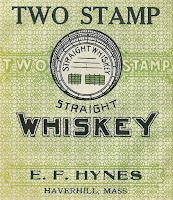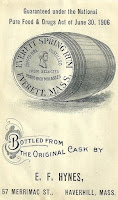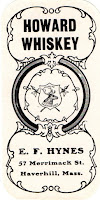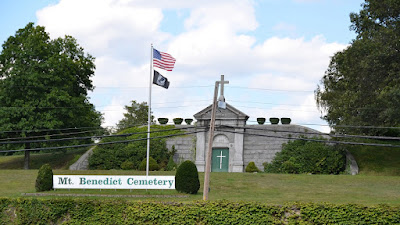Hynes of Haverhill Was Lord of Labels
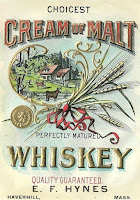 The photo below of a dingy storefront hardly seems that it could have been the place of origin for some of the most attractive whiskey labels in pre-Prohibition America. It depicts a window and door of a saloon and liquor store owned by Edward F. Hynes of Haverhill, Massachusetts, a whiskey man whose imagination in labeling his liquor belied his dreary surroundings.
The photo below of a dingy storefront hardly seems that it could have been the place of origin for some of the most attractive whiskey labels in pre-Prohibition America. It depicts a window and door of a saloon and liquor store owned by Edward F. Hynes of Haverhill, Massachusetts, a whiskey man whose imagination in labeling his liquor belied his dreary surroundings.
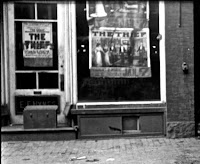 During the 18th and most of the 19th Century Haverhill was an important industrial center, with woolen mills, tanneries, ship building, and the manufacture of hats and shoes. Early in the 20th Century, even before other New England cities, its economy began to falter. Shown below is its main street, Merrimack Avenue, the location of Hynes’s enterprise.
During the 18th and most of the 19th Century Haverhill was an important industrial center, with woolen mills, tanneries, ship building, and the manufacture of hats and shoes. Early in the 20th Century, even before other New England cities, its economy began to falter. Shown below is its main street, Merrimack Avenue, the location of Hynes’s enterprise.
Born in Ireland about 1864, Hynes at the age of 19 immigrated to the United States in 1883. He likely had relatives in Haverhill, where he located for the rest of his life, becoming a citizen in 1888. His first three years in the city have gone unrecorded but we can assume that he must have been engaged in the liquor trade, likely working for another Irish-American saloonkeeper and learning the business. By 1887 Hynes had opened a liquor store at 137 Merrimack Avenue and a saloon he called E. F. Hynes Grill & Bar.
He also began creating his own brands of whiskey, not as a distiller but as a “rectifier,” someone buying “raw” whiskeys by the barrel from a variety of distillers and blending them to achieve a particular color, taste and smoothness.The process has been described as an “art form,” requiring the same delicacy of palate as a wine taster. Hynes then took the “art” one step further by bottling his liquor under more than a dozen names in attractive labels of his own design.

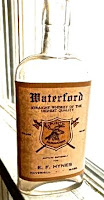 Among Hynes’ brands were: “ Black Bird Rye Malt Whiskey,” “Cream of Malt,” E. F. Hynes Pure Grain Alcohol,”, “Two Stamp Whiskey,” “Greenbrier,” “Hob – Nob,” “Howard Whiskey,” “Landmark Whiskey,” ”Old Parish Rye”, “Everett Springs,” “Waterford Straight Whiskey,” “Refreshmenter Rye,” and “Top Notch Rye.” It is interesting that the Irish immigrant did not bother with the expense and effort to trademark any of his labels. Hynes did, however, emboss his name on his bottles, thus identifying the origin even if the paper label was lost.
Among Hynes’ brands were: “ Black Bird Rye Malt Whiskey,” “Cream of Malt,” E. F. Hynes Pure Grain Alcohol,”, “Two Stamp Whiskey,” “Greenbrier,” “Hob – Nob,” “Howard Whiskey,” “Landmark Whiskey,” ”Old Parish Rye”, “Everett Springs,” “Waterford Straight Whiskey,” “Refreshmenter Rye,” and “Top Notch Rye.” It is interesting that the Irish immigrant did not bother with the expense and effort to trademark any of his labels. Hynes did, however, emboss his name on his bottles, thus identifying the origin even if the paper label was lost.
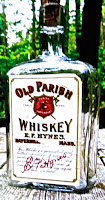
 The flagship of Hynes’ whiskeys was “Old Parish,” a name suggesting a church-y identification that may have been aimed at enraging the prohibitionists. It is the only label to bear the owner’s signature. Old Parish also contained the image of a shield with crossed battle axes rampant and the motto “Purity Paramount.” Although the label indicated that this was a trademark, since there is no record of Hynes ever having registered it with the federal government, the assertion would have been useless if the name had been pirated. Fortunately, it was not. Among his many brands, Old Parish is his only whiskey for which I can find advertising shot glasses.
The flagship of Hynes’ whiskeys was “Old Parish,” a name suggesting a church-y identification that may have been aimed at enraging the prohibitionists. It is the only label to bear the owner’s signature. Old Parish also contained the image of a shield with crossed battle axes rampant and the motto “Purity Paramount.” Although the label indicated that this was a trademark, since there is no record of Hynes ever having registered it with the federal government, the assertion would have been useless if the name had been pirated. Fortunately, it was not. Among his many brands, Old Parish is his only whiskey for which I can find advertising shot glasses.
Hynes would have been just another saloonkeeper selling whiskey on the side had it not been for the attractive, well-designed labels he used on his many brands of liquor. Shown here are a selection that demonstrates the reason why the company’s labels and bottles are sought by collectors.
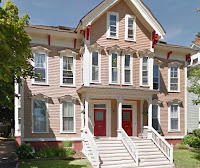 Throughout the growth and success of his enterprises, Hynes was having a personal life in Haverhill. At the age of 40, following a pattern of many Irish to marry late, he wed Ann, a woman five years his junior who was born in Massachusetts of Irish heritage. There is no indication of children, With his growing wealth Hynes was able to move Ann into a large home at 10 Park Street. Built in 1900, the house is shown here as it looks today. It was spacious enough that the Hynes could accommodate a live-in servant or two.
Throughout the growth and success of his enterprises, Hynes was having a personal life in Haverhill. At the age of 40, following a pattern of many Irish to marry late, he wed Ann, a woman five years his junior who was born in Massachusetts of Irish heritage. There is no indication of children, With his growing wealth Hynes was able to move Ann into a large home at 10 Park Street. Built in 1900, the house is shown here as it looks today. It was spacious enough that the Hynes could accommodate a live-in servant or two.
Records indicate that Hynes’ hobby was breeding and showing dogs — appropriately Irish terriers. The pedigree listed for his top canine offers a glimpse into just how Irish these dogs could be. Hynes “Darby,” born in April 1903 was accorded this ancestry: “By Mulvaney out of Peggy, by Norfolk Spike out of Biddy, by Barney’s Brother out of Biddy Malone.” That background should have been enough to qualify Darby for the Order of Ancient Hibernians.
With the coming of National Prohibition in 1920, after 32 years in business, Hynes was forced to close his saloon and liquor sales. Subsequent listings in Haverhill directories and the census indicate that the whiskey man, just 56 years old, retired. With him went all the brands of whiskey he had named along with their distinctive labels. Since none were revived after Repeal, all Hynes artifacts must be considered over 100 years old and “antiques.” “The Lord of Labels” Edward Hynes died in 1929 and was buried in Mount Benedict Cemetery in West Roxbury.
Notes: Special thanks to Peter Samuelson of Intervale, New Hampshire, a noted collector of labeled whiskeys, for the picture of the Hynes Old Parish flask, thus providing the inspiration to devote a post to Hynes and his attractive liquor labels.
Addendum: After this vignette had been posted Mr. Samuelson sent me another
photo of a Hynes jug from his collection. This one advertises“Old Black Pete” Whiskey and shows an elderly African American gentleman standing in a cotton field. It is included here.

